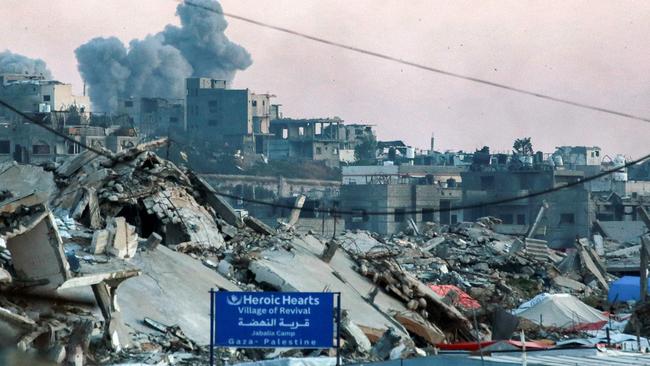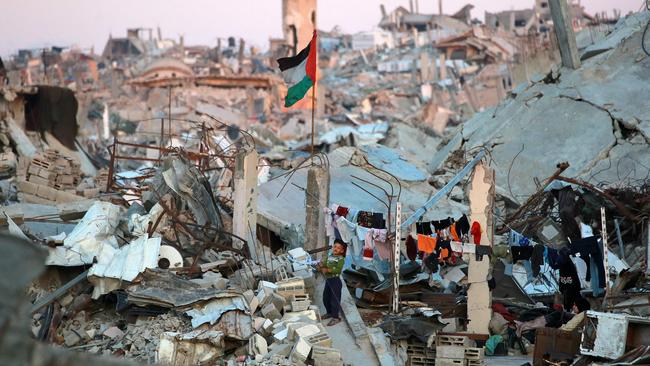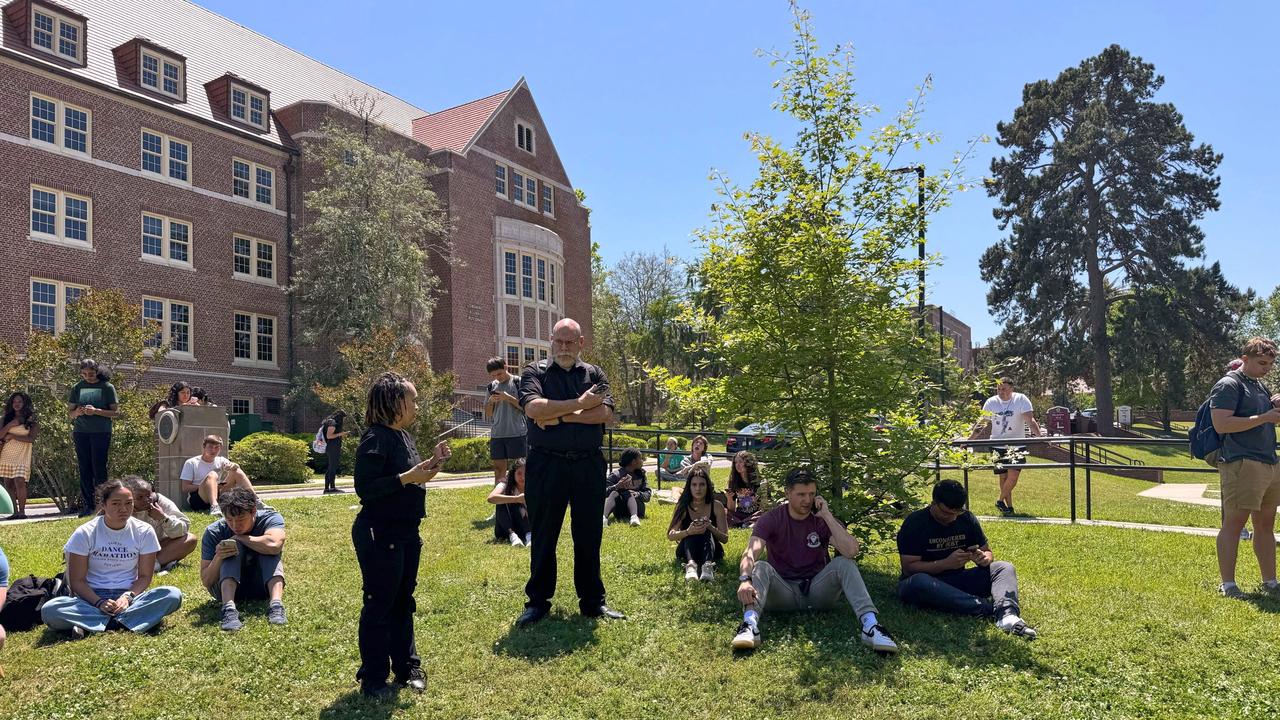Israel takes over a third of Gaza as Hamas considers new deal
Israel has declared security zones in swathes of the north and south while pushing out their populations as part of a new strategy to ratchet up pressure on Hamas.

Israeli troops have taken over about a third of the Gaza Strip in renewed military action, declaring security zones in swathes of the north and south while pushing out their populations as part of a new strategy to ratchet up pressure on Hamas.
After relying mainly on air strikes and tactical raids for the first year and a half of the war, Israel is now seizing land and threatening to hold it indefinitely as it presses Hamas to release the hostages still held in Gaza.
The shift reflects a realignment of the country’s approach to security to carve out deeper buffer zones in the wake of the deadly Oct. 7, 2023, attacks led by Hamas. It is also a way to create new consequences for Hamas by threatening to shrink Palestinians’ land if the hostages aren’t released.
Israel went back to war in March, after ceasefire talks broke down with Israel accusing
Hamas of not releasing hostages and Hamas accusing Israel of failing to carry through with discussions over a permanent end to the fighting.
Hamas is now considering an Egyptian proposal to release as many as 11 of the 24 hostages still believed to be alive along with the bodies of several more in exchange for a ceasefire lasting up to 70 days, the Egyptian officials said. The proposal is nearly identical to one offered by Israel and the US before the fighting resumed.
The proposal also includes a demand for Hamas to drop their weapons, a demand that has been strongly rejected by Hamas, the Egyptian officials said.

The deal would give Hamas a break from the fighting but would further defer any discussions over an end to the war. Israeli Prime Minister Benjamin Netanyahu has been pushing for a deal that would free hostages but allow Israel to continue the war until Hamas is defeated or disarms on its own.
Since Israel renewed its ground assault in Gaza in mid-March, more than 30% of the enclave has come under Israeli military control, an Israeli official said. Much of the movement has been in the south, where Israel carved out a new security corridor encircling the border city of Rafah and warning the area would become part of Israel’s security buffer.
Before moving in, Israel informed Egypt, which borders Rafah, that it intended to keep the area for the long term as a buffer with Rafah completely cut off from cities to the north, Egyptian officials said. Israel also said it planned to expand security zones around Gaza City in the north, the Egyptian officials said.
Asked about the moves, Israel’s military said it was following an updated defence strategy that calls for maintaining a broad military presence in buffer zones that have been cleared of threats. Evacuations are ordered to reduce harm to civilians, it said.
“Many territories are being seized and added to the security zones of the State of Israel, leaving Gaza smaller and more isolated,” Israeli Defense Minister Israel Katz said Wednesday.
The prospect of a permanent loss of land opens old wounds for Gazans, many of whom are descendants of families that were forced out or fled during the fighting that accompanied the founding of Israel more than 75 years ago.

If Hamas baulks over its ceasefire offer, Israeli officials and analysts say the Israeli military will continue to divide Gaza into separate enclaves, evacuate civilians and try to trap any remaining militants.
“What we saw in the first 15 months of war is that when we attack one hide-out, they would move to a different one,” said Yaron Buskila, a lieutenant colonel in Israel’s military reserves and chief executive of Israel Defense and Security Forum, a security-oriented think tank.
“We understood we have to split the areas, so they cannot move from one to another,” he said. “Otherwise, it’s like water.”
The bulk of Gaza’s pre-war population of more than two million has been displaced multiple times by Israel’s military over the past 18 months. Many had returned to their old neighbourhoods earlier this year – a key achievement of the two-month ceasefire that took effect in January – but were forced to flee again after Israel resumed air strikes and ground operations.
Nearly 400,000 Palestinians were displaced by Israeli evacuation orders between March 18 and April 8, the United Nations said. Around two-thirds of the enclave is either under evacuation orders or considered by Israel to be a no-go zone, the U.N. said.
Israel said Saturday that its troops completed the creation of the so-called Morag corridor, an east-west route that cuts off Rafah from the rest of the territory. About two weeks earlier, Israel issued evacuation orders for the entire city, where hundreds of thousands lived before the war. Troops have been razing parts of Rafah, which was already heavily damaged from previous fighting.
Sara Sobhi, a 32-year-old mother of two, said the fighting started back up the very same day she sent furniture to the half-finished home in Rafah, where she had hoped to return. Now, she is sheltering in the nearby city of Khan Younis and watching Rafah “evaporate into black columns of smoke.” Sobhi, her five sisters and their parents have together lost six homes in Rafah. She said that while losing their homes was hard, the idea of losing the land itself hits even harder.
“Let’s assume we gave up the homes, but we don’t want to give up the lands,” she said. “I was happy that I bought land before I became 30, and now it’s gone.” Buskila said troops in Rafah were removing Hamas’s underground tunnels, buildings where the group left explosives and munitions, and infrastructure such as sniper posts that could facilitate future fighting.
Israel is also creating another corridor north of Gaza City that cuts it off from the once densely populated neighbourhoods to its north.
In March, Israeli troops retook control of the Netzarim corridor, a sprawling security zone that Israel has expanded throughout the war, cutting off northern Gaza from the rest of the enclave.
The result is that the 40-km-long Palestinian enclave is currently divided by Israel’s military into four separate areas. Buskila said he expected further divisions to come.
The strategy is different from the one Israel employed earlier in the war, when it moved troops from place to place and said repeatedly it wouldn’t occupy territory. It now is likely seizing territory to maximise leverage at the negotiating table with Hamas, but it isn’t clear what the government will do with those areas if the two sides can’t come to an agreement, Israeli security analysts said.
Israeli officials have said the country will keep a permanent buffer zone between itself and Gaza. That previously meant a belt about half a mile wide along Gaza’s perimeter, where Israel has razed nearly all infrastructure.
In the Egyptian ceasefire proposal Hamas is considering, Israel would have to relinquish control of corridors that bisect Gaza, as well as agree to release hundreds of Palestinian prisoners and to stop blocking the entry of humanitarian aid into the enclave, the Egyptian officials said.
Israel closed all crossings into Gaza in March. U.N. officials have warned of dire humanitarian consequences.
Dow Jones



To join the conversation, please log in. Don't have an account? Register
Join the conversation, you are commenting as Logout